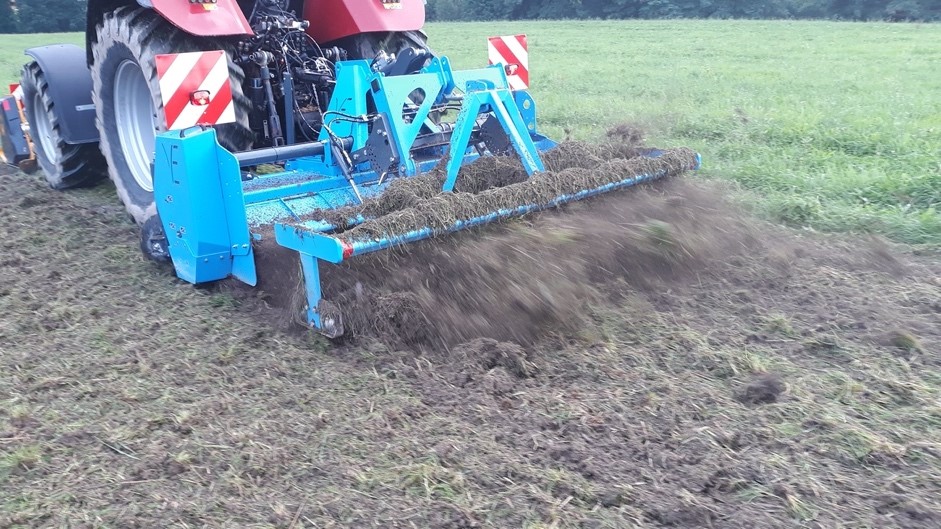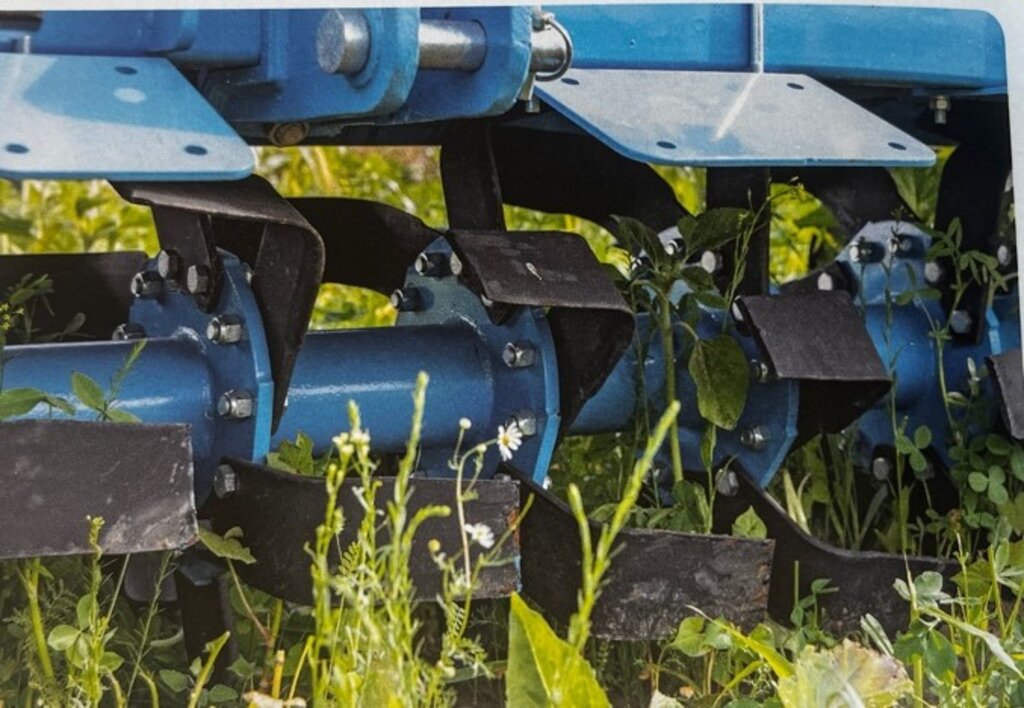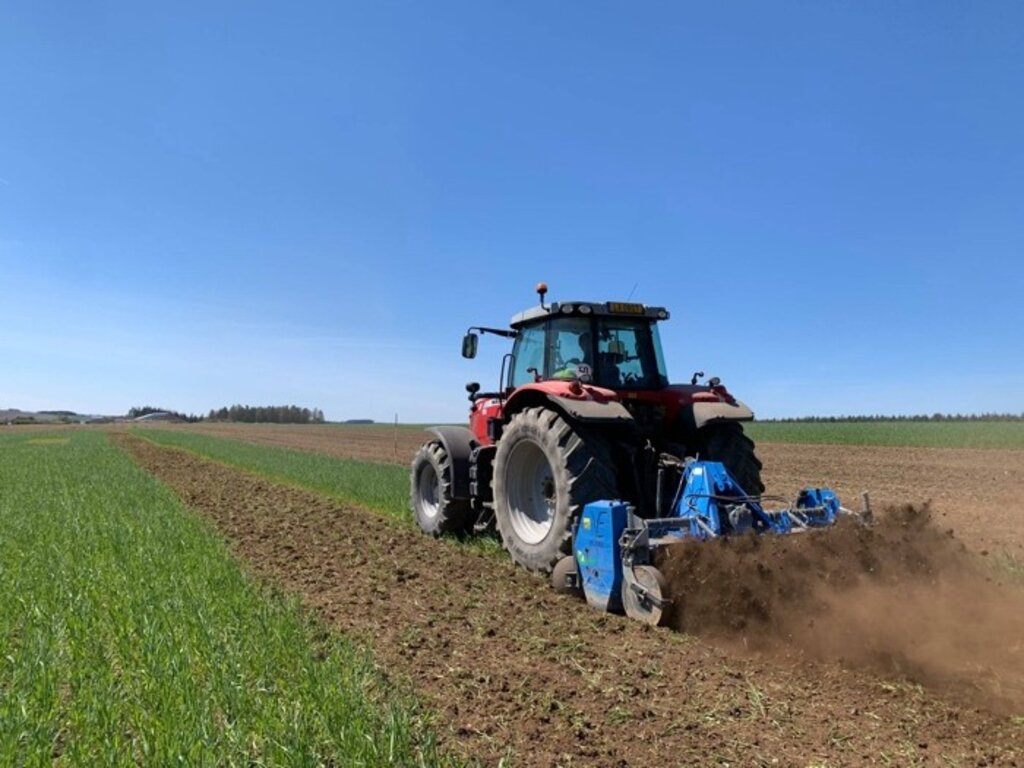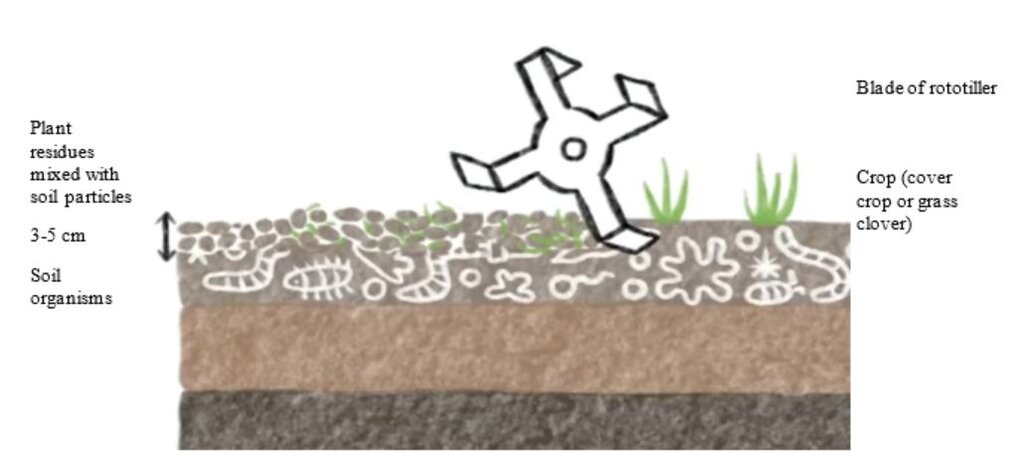Shallow rotary tillage with microbial digestion [Luxembourg]
- Creation:
- Update:
- Compiler: Alan Radbourne
- Editor: –
- Reviewers: William Critchley, Rima Mekdaschi Studer
Flächenrotte
technologies_6878 - Luxembourg
View sections
Expand all Collapse all1. General information
1.2 Contact details of resource persons and institutions involved in the assessment and documentation of the Technology
Key resource person(s)
SLM specialist:
Mangen Michèle
Lycée technique Agricole (LTA)
Luxembourg
SLM specialist:
Ruf Thorsten
IBLA institute fir biologesch Landwirtschaft an Agrarkultur Lëtzebuerg
Luxembourg
land user:
Rossler Daniel
Farmer
Luxembourg
Name of project which facilitated the documentation/ evaluation of the Technology (if relevant)
European Interreg project FABulous Farmers1.3 Conditions regarding the use of data documented through WOCAT
The compiler and key resource person(s) accept the conditions regarding the use of data documented through WOCAT:
Yes
1.4 Declaration on sustainability of the described Technology
Is the Technology described here problematic with regard to land degradation, so that it cannot be declared a sustainable land management technology?
No
2. Description of the SLM Technology
2.1 Short description of the Technology
Definition of the Technology:
Shallow rotary tillage with microbial digestion is a technique that is used to destroy cover crops and to manage stubble. The plant material is broken down to small pieces and incorporated into the surface layer of the soil. During the process bacteria and microbes are added to break down the plant material.
2.2 Detailed description of the Technology
Description:
The use of the herbicide glyphosate for terminating catch/ cover crops or field forage is increasingly coming under criticism. Simultaneously there is a movement towards farming methods that preserve soil health by reducing deep tillage. Thus, farmers have developed a surface rotting system that protects soil while safely eliminating a cover crop. “Shallow rotary tillage with microbial digestion” is a technique that is used to destroy cover crops and to manage stubble. Overwintering catch crops/undersown plants or field forage are turned over in spring or autumn. The plant material is broken down to small pieces and incorporated into the surface layer of the soil (around 5 cm deep). By use of a field rototiller, the vegetation is mechanically destroyed and mixed with the soil particles. Depending on the activity of organisms in the soil, microorganisms may then be introduced to accelerate the decomposition process of the plant material. A second pass may be required after 7- 14 days. Aerobic decomposition of the plant material takes place on the surface/ within the top layer of the soil. The advantages of this surface rotting can be summarised as follows:
•No synthetic agents are used.
•The soil is not inverted but only superficially mixed.
•The soil structure and its pore system are preserved.
•Organic material is introduced into the soil and thus soil organisms are promoted.
The challenge with surface rotting is the weather. The soil must be sufficiently dry to avoid creating smear layers, but if it is too dry, the fuel input to power the machine increases. However, if the weather is too wet after rototilling, there is a risk of re-growth of the plants. The blades of the tiller must be sufficiently sharp to cut the vegetative core of the plants well. The use of effective microorganisms is not yet scientifically proven - and the price of these products is high: some farmers even produce their own microbially-rich “compost tea”.
2.3 Photos of the Technology
2.4 Videos of the Technology
Comments, short description:
https://www.youtube.com/watch?v=gig2fknIpXM
Date:
01/04/2020
Location:
Luxemburg
2.5 Country/ region/ locations where the Technology has been applied and which are covered by this assessment
Country:
Luxembourg
Region/ State/ Province:
Ösling
Specify the spread of the Technology:
- evenly spread over an area
If precise area is not known, indicate approximate area covered:
- 1-10 km2
Is/are the technology site(s) located in a permanently protected area?
No
Map
×2.6 Date of implementation
Indicate year of implementation:
2020
2.7 Introduction of the Technology
Specify how the Technology was introduced:
- through land users' innovation
- through projects/ external interventions
Comments (type of project, etc.):
Developed through farmer's innovative idea to trial this system, and supported as part of the FABulous farmers project
3. Classification of the SLM Technology
3.1 Main purpose(s) of the Technology
- improve production
- reduce, prevent, restore land degradation
- create beneficial economic impact
3.2 Current land use type(s) where the Technology is applied
Land use mixed within the same land unit:
No

Cropland
- Annual cropping
- Perennial (non-woody) cropping
Number of growing seasons per year:
- 1
Is intercropping practiced?
Yes
Is crop rotation practiced?
Yes
3.3 Has land use changed due to the implementation of the Technology?
Has land use changed due to the implementation of the Technology?
- No (Continue with question 3.4)
3.4 Water supply
Water supply for the land on which the Technology is applied:
- rainfed
3.5 SLM group to which the Technology belongs
- improved ground/ vegetation cover
- minimal soil disturbance
3.6 SLM measures comprising the Technology

agronomic measures
- A2: Organic matter/ soil fertility
3.7 Main types of land degradation addressed by the Technology

soil erosion by water
- Wt: loss of topsoil/ surface erosion
- Wg: gully erosion/ gullying

physical soil deterioration
- Pk: slaking and crusting

water degradation
- Hq: decline of groundwater quality
3.8 Prevention, reduction, or restoration of land degradation
Specify the goal of the Technology with regard to land degradation:
- prevent land degradation
- reduce land degradation
4. Technical specifications, implementation activities, inputs, and costs
4.1 Technical drawing of the Technology
Technical specifications (related to technical drawing):
Tillage depth: 5 cm
Speed of tractor: depending on soil type and soil conditions
Timing: Autumn or Spring before sowing of main crop
Number of applications: max 2
Author:
Michèle Mangen
Date:
01/04/2023
4.2 General information regarding the calculation of inputs and costs
Specify how costs and inputs were calculated:
- per Technology area
Indicate size and area unit:
1ha
If using a local area unit, indicate conversion factor to one hectare (e.g. 1 ha = 2.47 acres): 1 ha =:
2.4 acres
other/ national currency (specify):
Eur
If relevant, indicate exchange rate from USD to local currency (e.g. 1 USD = 79.9 Brazilian Real): 1 USD =:
0.91
Indicate average wage cost of hired labour per day:
280
4.5 Maintenance/ recurrent activities
| Activity | Timing/ frequency | |
|---|---|---|
| 1. | Change blades of rototiller | Depends on soil type and amount of stones in the soil. |
| 2. | Agronomic: first tillage of field | Before sowing main crop |
| 3. | Agronomic: second tillage of field (optional) | Before sowing main crop |
Comments:
Applying effective microorganisms is done during tillage. If effective microorganisms are bought no time is needed for production. If applying "compost tea" then time for preparation has to be included
4.6 Costs and inputs needed for maintenance/ recurrent activities (per year)
| Specify input | Unit | Quantity | Costs per Unit | Total costs per input | % of costs borne by land users | |
|---|---|---|---|---|---|---|
| Equipment | Tractor+Rototiller+labour | ha | 1.0 | 105.0 | 105.0 | 100.0 |
| Fertilizers and biocides | Effective microorganisms (EM) | litre | 150.0 | 1.5 | 225.0 | 100.0 |
| Other | Consumables (usage of tillers) | ha | 1.0 | 45.0 | 45.0 | 33.0 |
| Total costs for maintenance of the Technology | 375.0 | |||||
| Total costs for maintenance of the Technology in USD | 412.09 | |||||
If land user bore less than 100% of costs, indicate who covered the remaining costs:
Water fund grant
4.7 Most important factors affecting the costs
Describe the most determinate factors affecting the costs:
Soil type defines speed of tractor and thus fuel, labour and recurrent maintenance costs.
5. Natural and human environment
5.1 Climate
Annual rainfall
- < 250 mm
- 251-500 mm
- 501-750 mm
- 751-1,000 mm
- 1,001-1,500 mm
- 1,501-2,000 mm
- 2,001-3,000 mm
- 3,001-4,000 mm
- > 4,000 mm
Specify average annual rainfall (if known), in mm:
800.00
Specifications/ comments on rainfall:
October-January rainfall is > 75mm per month
March-April rainfall is lowest <70mm per month
Seasons with extreme heavy rainfalls (short and a lot of water are around May)
Agro-climatic zone
- sub-humid
5.2 Topography
Slopes on average:
- flat (0-2%)
- gentle (3-5%)
- moderate (6-10%)
- rolling (11-15%)
- hilly (16-30%)
- steep (31-60%)
- very steep (>60%)
Landforms:
- plateau/plains
- ridges
- mountain slopes
- hill slopes
- footslopes
- valley floors
Altitudinal zone:
- 0-100 m a.s.l.
- 101-500 m a.s.l.
- 501-1,000 m a.s.l.
- 1,001-1,500 m a.s.l.
- 1,501-2,000 m a.s.l.
- 2,001-2,500 m a.s.l.
- 2,501-3,000 m a.s.l.
- 3,001-4,000 m a.s.l.
- > 4,000 m a.s.l.
Indicate if the Technology is specifically applied in:
- not relevant
5.3 Soils
Soil depth on average:
- very shallow (0-20 cm)
- shallow (21-50 cm)
- moderately deep (51-80 cm)
- deep (81-120 cm)
- very deep (> 120 cm)
Soil texture (topsoil):
- coarse/ light (sandy)
- medium (loamy, silty)
Soil texture (> 20 cm below surface):
- coarse/ light (sandy)
- medium (loamy, silty)
Topsoil organic matter:
- medium (1-3%)
5.4 Water availability and quality
Ground water table:
5-50 m
Availability of surface water:
good
Water quality (untreated):
good drinking water
Water quality refers to:
both ground and surface water
Is water salinity a problem?
No
Is flooding of the area occurring?
No
5.5 Biodiversity
Species diversity:
- medium
Habitat diversity:
- medium
5.6 Characteristics of land users applying the Technology
Sedentary or nomadic:
- Sedentary
Market orientation of production system:
- commercial/ market
Off-farm income:
- less than 10% of all income
Relative level of wealth:
- rich
- very rich
Individuals or groups:
- individual/ household
Level of mechanization:
- mechanized/ motorized
Gender:
- women
- men
Age of land users:
- middle-aged
5.7 Average area of land used by land users applying the Technology
- < 0.5 ha
- 0.5-1 ha
- 1-2 ha
- 2-5 ha
- 5-15 ha
- 15-50 ha
- 50-100 ha
- 100-500 ha
- 500-1,000 ha
- 1,000-10,000 ha
- > 10,000 ha
Is this considered small-, medium- or large-scale (referring to local context)?
- medium-scale
5.8 Land ownership, land use rights, and water use rights
Land ownership:
- individual, not titled
Land use rights:
- leased
- individual
Water use rights:
- communal (organized)
Are land use rights based on a traditional legal system?
Yes
5.9 Access to services and infrastructure
health:
- poor
- moderate
- good
education:
- poor
- moderate
- good
technical assistance:
- poor
- moderate
- good
employment (e.g. off-farm):
- poor
- moderate
- good
markets:
- poor
- moderate
- good
energy:
- poor
- moderate
- good
roads and transport:
- poor
- moderate
- good
drinking water and sanitation:
- poor
- moderate
- good
financial services:
- poor
- moderate
- good
6. Impacts and concluding statements
6.1 On-site impacts the Technology has shown
Socio-economic impacts
Production
crop production
Comments/ specify:
Cover crop provides green manure for soil fertility
crop quality
land management
Comments/ specify:
Less crusting issues with better water retention in soil
Income and costs
expenses on agricultural inputs
Comments/ specify:
Costs increased with undertaking new technology due to additional labour. Aim is to be cost neutral in future but using mechanical rather than chemical methods
workload
Comments/ specify:
Takes more time
Ecological impacts
Water cycle/ runoff
water quantity
Comments/ specify:
Better water retention in soil with cover crops
Soil
soil moisture
Comments/ specify:
Better water retention in soil with cover crops
soil cover
soil loss
soil crusting/ sealing
soil compaction
nutrient cycling/ recharge
soil organic matter/ below ground C
Biodiversity: vegetation, animals
Vegetation cover
biomass/ above ground C
beneficial species
Climate and disaster risk reduction
flood impacts
drought impacts
6.3 Exposure and sensitivity of the Technology to gradual climate change and climate-related extremes/ disasters (as perceived by land users)
Gradual climate change
Gradual climate change
| Season | increase or decrease | How does the Technology cope with it? | |
|---|---|---|---|
| seasonal temperature | spring | increase | moderately |
| seasonal temperature | autumn | increase | moderately |
| seasonal rainfall | spring | decrease | moderately |
| seasonal rainfall | autumn | decrease | moderately |
6.4 Cost-benefit analysis
How do the benefits compare with the maintenance/ recurrent costs (from land users' perspective)?
Short-term returns:
slightly negative
Long-term returns:
neutral/ balanced
6.5 Adoption of the Technology
- 1-10%
Of all those who have adopted the Technology, how many did so spontaneously, i.e. without receiving any material incentives/ payments?
- 91-100%
6.6 Adaptation
Has the Technology been modified recently to adapt to changing conditions?
No
6.7 Strengths/ advantages/ opportunities of the Technology
| Strengths/ advantages/ opportunities in the land user’s view |
|---|
| Cover crop /fodder crop termination is without the use of glyphosate or the plough |
| Water retention capacity of the soil is increased (resilience to drought increased) |
| Strengths/ advantages/ opportunities in the compiler’s or other key resource person’s view |
|---|
| Soil health is increased. |
| Farmers independence of external inputs is decreased |
| Acceptance of field fodder and cover crops is increased |
6.8 Weaknesses/ disadvantages/ risks of the Technology and ways of overcoming them
| Weaknesses/ disadvantages/ risks in the land user’s view | How can they be overcome? |
|---|---|
| costs (fuel/time). | |
| timing and weather have a big impact on success | experience |
7. References and links
7.1 Methods/ sources of information
- field visits, field surveys
2
- interviews with land users
2
- interviews with SLM specialists/ experts
1
When were the data compiled (in the field)?
01/04/2022
7.2 References to available publications
Title, author, year, ISBN:
Regenerative Landwirtschaft, Dietmar Näser, 2020, ISBN 978-8186-0695-4
Available from where? Costs?
Ulmer.de 34,95€
7.3 Links to relevant online information
Title/ description:
Home Page of a German advisor
URL:
https://www.regenerative-landwirtschaft.de/
Title/ description:
Swiss home page of regenerative agriculture
URL:
https://agrar.em-schweiz.ch/flaechenrotte
Title/ description:
Austrian homepage of equipment seller
URL:
http://www.ackerfräse.at/
Links and modules
Expand all Collapse allLinks
No links
Modules
No modules








